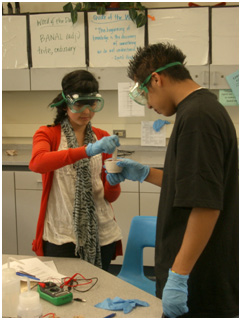Outreach Program Uses Berry Power To Engage High School Students

By Michael G. Walter
How can you make a solar cell out of a blackberry? And, how many solar cells can you make using a single blackberry?
These are the questions students in Melinda Reynolds and Alex Pratt's chemistry classes at John Muir High School in Pasadena, California are trying to answer. No, we're not talking about a blackberry smartphone (which is definitely not a solar cell) but rather, the darkly colored sweet berry that grows wild in many parts of the Western U.S.
Blackberries contain a strongly light-absorbing dye molecule called anthocyanin, which occurs in many types of fruits and berries. It's the compound that gives blackberries, raspberries, blueberries, and pomegranates their color. These dyes can be extracted and used in a dye-sensitized TiO2 solar cell to absorb light and then convert the light into electrical energy.
This is the basis of an outreach project I'm leading at John Muir High School to bring the latest solar energy technologies into the science curriculum. The solar cell labs are also being carefully designed to integrate important chemistry and physics concepts that meet the California State education standards. The long-term goal of the program is to have the solar cell labs (or others like it) taught year after year as a collaborative effort between John Muir HS science faculty and postdoctoral researchers at Caltech.
 |  |
During the first installment of program in fall of 2009, students learned how the dye molecules in these fruits absorb certain wavelengths of light and allow other colors to be transmitted or reflected. The students extracted the dyes by crushing the plant material with a mortar and pestle. Then, using a spectrophotometer, students analyzed which wavelengths of light were absorbed by several natural dyes, including anthocyanin from blackberries and chlorophyll extracted from spinach leaves, which also can be used in a dye-sensitized solar cell.
The students used their spectra to construct calibration graphs to determine the concentration of anthocyanin dye in a single blackberry. They found that indeed a significantly larger concentration of dye was found in ripe blackberries compared with less ripe fruit, consistent with common experience that the ripest berries are the darkest. This agrees with findings reported in the literature that by the time the fruit fully ripens, there is a four-fold increase in dye concentration. Student calculations of dye concentration came very close to known values for anthocyanin-containing fruits like blackberries.
In the next portion of the experiment, which runs this spring, students prepare blackberry solutions again to transfer dye to TiO2 electrodes and calculate how much dye is absorbed onto the electrode surface. The electrodes are made using a paste of extremely small particles of TiO2 that are spread out in a thin layer on transparent conductive glass electrodes. The particles provide a huge surface area for the dye molecules to stick to, and they provide an electron pathway for the generated electrical current to be collected. A significant portion of light is absorbed by the dye, even though only a single layer of dye molecules is attached to the surface. The dyed electrode goes from white to a dark purple. The students will use the known dye concentration before and after the electrodes are immersed in the dye solutions to determine how much dye is adsorbed, and therefore, they will be able to calculate the number of solar cells that can be made from the juice of just one blackberry.
A test run of this lab was performed last spring and involved six John Muir HS chemistry classes with over 150 students participating in the lab exercises. Several students helped to prepare the lab by cutting up conductive glass electrodes and preparing electrolyte solutions used for the experiments. Many students in the class saw photovoltages of 0.4 to 0.5 V with good photovoltaic device stability. Solar cells were tested under simulated illumination, and they were taken outside to use in natural light. Students connected 4 blackberry solar cells in series to obtain photovoltages exceeding 1.5 V.
The blackberry lab is more than just a cool solar energy experiment to demonstrate how adsorbed photons can be turned into electricity. It begins to teach students how a multi-disciplinary approach in science and engineering can be used to solve some of the most critical global technological challenges. One of the most pressing of these is the need to develop solar energy materials and devices that are economically feasible.
Students from John Muir HS will have the opportunity to visit Caltech on field trips and learn more about research labs that study the same dye-sensitized TiO2 solar cells which the students are building using the blackberries. This program also provides future opportunities for postdoctoral researchers and graduate students to participate in and develop outreach activities like the ones at John Muir HS. Another postdoctoral researcher from Caltech, Mike Rose has also begun helping to develop and implement the first installment of the program.
We have recently launched a website with more information where you can track the progress of the John Muir HS students. The site provides resources and lab materials for science teachers at all education levels. To find out more information about the blackberry solar cells labs at John Muir High School visit: www.blackberrysolarcell.org
Michael Walter is a postdoctoral scholar at the California Institute of Technology in Pasadena and is funded through a postdoctoral fellowship from the National Science Foundation. Walter is an alumnus of the 2009 Chemistry Communication Leadership Institute at the University of Washington.
Images
Top: Dyes extracted from blackberries can be used in a dye-sensitized TiO2 solar cell to absorb light and then convert the light into electrical energy.
Middle: Vivian and Hector preparing the blackberry juice dye solution.
Bottom: A TiO2 electrode floating in a pool of crushed blackberries soaking up the dye.

|